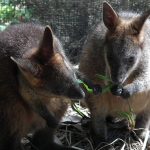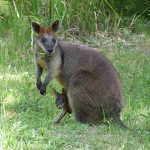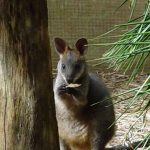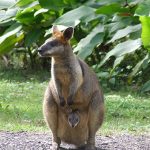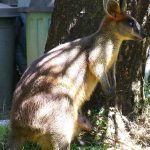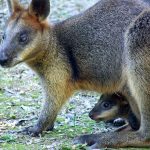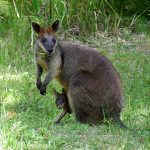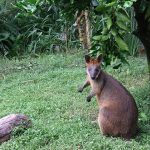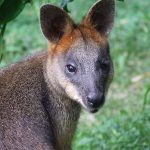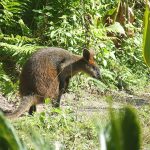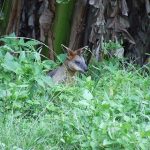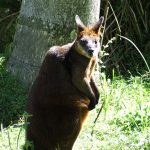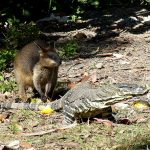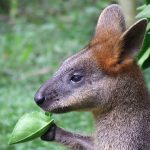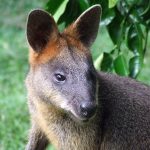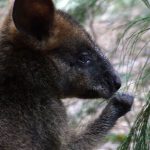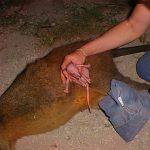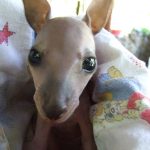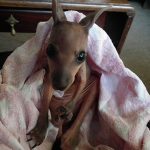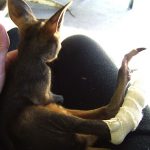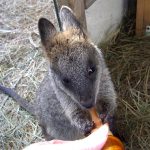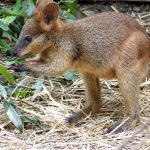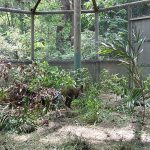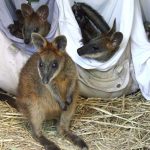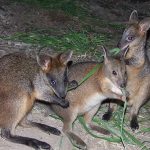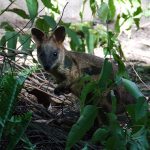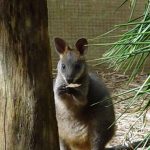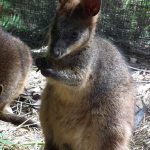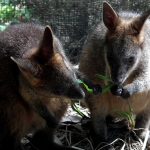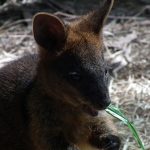SWAMP WALLABY
The Mysterious Swamp Wallaby
Meet the mysterious Swamp Wallaby, a unique and intriguing marsupial native to the wild landscapes of eastern and southern Australia, spanning from Cape York all the way to the southwestern reaches of Victoria. These enigmatic creatures have a lifestyle that’s as captivating as their appearance.
Life in the Shadows
In the heart of the forest, Swamp Wallabies make their homes amidst dense undergrowth, where they master the art of concealment. By day, they cleverly disguise themselves within thick grass and tangled bushes, staying hidden from prying eyes. However, as the sun dips below the horizon, these nocturnal wanderers emerge from their leafy hideaways, embarking on a quest for sustenance.
A Diverse Diet
Their culinary preferences are as diverse as the landscapes they inhabit. Swamp Wallabies are true vegetarians, feasting on a smorgasbord of grasses, shrubs, and ferns. The lush forest floor provides them with an ever-changing menu, and they partake in this nocturnal feast with enthusiasm.
Striking Appearance and Distinctive Movement
What truly sets the Swamp Wallaby apart is its striking appearance and unique behaviour:
- Colouration: Dark brown fur above, lighter brown to yellowish underneath, and a distinctive light brown cheek stripe.
- Extremities: Their paws and feet are typically darker, adding to their charismatic appeal.
- Gait: Swamp Wallabies walk with a distinctive style—heads held low, tails stretched straight behind. This manner of moving, combined with their dark cloak, helps them blend seamlessly into shadowy forest habitats.
A Unique Place in the Animal Kingdom
In the zoological world, the Swamp Wallaby stands out as a one-of-a-kind creature. It is the sole living member of the genus Wallabia, making it a truly exceptional and intriguing species.
Rare Genetic Distinction
Beyond their unique appearance and behaviour, Swamp Wallabies also have a fascinating genetic story. While the genus Macropus (which includes kangaroos and many wallabies) typically has 16 chromosomes, Swamp Wallabies are different:
| Sex | Number of Chromosomes |
|---|---|
| Male | 11 |
| Female | 10 |
This unusual difference showcases the marvels of evolutionary diversity within Australia’s marsupials.
Size and Structure
Swamp Wallabies are robust yet agile:
- Adult Males: Around 17 kilograms, with a head and body length of 76 centimetres.
- Adult Females: Slightly lighter at 13 kilograms, and about 70 centimetres in length.
- Tail: Long and powerful, often matching the length of their bodies—76 centimetres for males and 69 centimetres for females.
Specialised Teeth for a Tough Diet
One of the most remarkable features of the Swamp Wallaby is its fourth premolar tooth. Unlike other mammals, this tooth is never shed. It is perfectly adapted for grinding down the coarse, fibrous plant material that dominates their diet, allowing them to thrive in habitats where food can be tough and unyielding.
A Story of Reproduction
Reproduction in the Swamp Wallaby is a year-round affair, with some truly fascinating details:
- Sexual Maturity: Reached at 15 to 18 months.
- Gestation: Only 33 to 38 days, after which a single joey is born.
- Pouch Life: The young joey spends 8 to 9 months safely tucked in its mother’s pouch.
- Extended Care: Even after leaving the pouch, the joey continues to return for comforting feeds until about 15 months old.
Sensory Experience of the Swamp Wallaby’s World
Imagine standing on the edge of a sun-dappled forest at dusk. The air is cool and scented with damp earth and crushed ferns. As shadows deepen, you might catch a faint rustling in the undergrowth—the soft patter of padded feet. A Swamp Wallaby, almost invisible in its dark coat, pauses among the bracken. Its keen nose twitches, testing the air for the scent of fresh shoots. With a gentle nip, it samples a tender leaf, the sound barely audible against the chorus of nocturnal insects.
Conservation and Connection
The Swamp Wallaby, with its dark, enigmatic charm and remarkable adaptations, is more than just a unique Australian native. It is a vital part of its ecosystem, helping to shape the plant communities of its habitat. As forests and wetlands face increasing pressures, understanding and valuing creatures like the Swamp Wallaby becomes ever more important.
By learning about these remarkable marsupials, we are reminded of the intricate balance of life in Australia’s wild places—and of our shared responsibility to protect it for future generations.
Summary Table
| Feature | Details |
|---|---|
| Scientific Name | Wallabia bicolor |
| Habitat | Forests, woodlands, dense undergrowth |
| Range | Eastern & Southern Australia |
| Diet | Grasses, shrubs, ferns |
| Weight (Male/Female) | 17 kg / 13 kg |
| Length (Male/Female) | 76 cm / 70 cm |
| Tail Length (Male/Female) | 76 cm / 69 cm |
| Chromosomes (Male/Female) | 11 / 10 |
| Unique Adaptations | Never-shed fourth premolar, cryptic behaviour |
| Conservation Status | Least Concern (IUCN), but habitat loss is a risk |
Final Thought
The Swamp Wallaby is truly a creature of wonder—an embodiment of the quiet mysteries and hidden beauties of the Australian wild. Its story calls us to look more closely, to listen more carefully, and to cherish the wild places that make such unique life possible.

